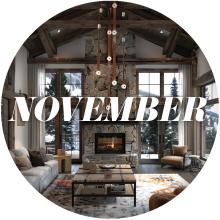For the first time ever, thought leaders from two industry associations — the American Society of Furniture Designers (ASFD) and Women in the Home Industries Today (Withit) — came together at the spring High Point Market for a provocative discussion about the future of product design.
Led by ASFD Executive Director John Conrad, host of the popular podcast “Design Between The Lines,” panelists included Catina Roscoe, furniture designer, founder of Catina Unlimited Designs and ASFD President; Fred Spector, furniture designer and Head of the Furniture Design department at Savannah College of Art and Design (SCAD); Katharine Lambeth, Chief Technology Officer at Steelyard; Aimee Kurzner, Director of Furniture at Currey & Co.; Christian Dunbar, maker and Principal of Christian Dunbar Designs; and Amy Archer, Vice President of Merchandising for LEE upholstery.
The following distillation of their insights explores where we are as an industry and offers a tantalizing view of where we’re headed.
The Changing Process
“For a freelance designer like myself, it used to be about hand-drawing pretty pictures and those pretty pictures were made into pretty furniture,” Roscoe said. “There was no technology (other than AutoCad), behind them, and no analytics influencing the thought process. Today it’s a whole new world.”
Certainly, “it’s more important than ever for designers to understand technology and how technology can benefit each of us,” said Lambeth of Steelyard, which offers a Cloud-based platform that helps interior designers connect and build relationships with manufacturers. “Our goal at Steelyard is to make the process more intuitive so designers can become more successful in their businesses. They can go be creative; we’ll take care of the rest.”
But it’s not just advancing technology impacting the design process now. “For me, the biggest change is that when I first started out as a furniture designer, 80 percent of the products were made in the U.S.,” Spector noted. “Today, very few of them are, and that has changed the entire product development cycle. Lead times are much longer now. It used to be that you could start designing something for spring market in January, and a month or two after the market in April, we would be seeing samples for the fall. Now, that’s all changed, and it’s more like a year or even a year-and-a-half out, as opposed to six months.”
Archer reported it’s the “inspiration that’s changed. When it came to product development, it used to be what’s in our backyard. Twenty years ago, we’d see what our local stores were doing, we’d thumb through magazines, and now, we’re in the midst of a visual mecca and we have to have the guts to find our own voice, to figure out what has and hasn’t been done in order to craft what the next thing will be. It’s a delicate dance we must perform to make something that stands apart.”
Roscoe agreed. “We have access to social media and websites promoting various lifestyles that product designers never had in the past, all of which not only serve as sources of inspiration, but offer much broader audiences for our work. There’s a lot more design cachet floating around out there.”
Indeed, the impact of social media “promotes great design from talented designers and gets your product out there where the consumer sees it much quicker,” said Lambeth. “But it can also mean that your design will not be as unique for as long as it used to be. Things can be adopted and re-engineered much faster now.”
“And that makes it really difficult to be original now,” Kurzner chimed in. “As designers, we’re all looking for something and we’re actually looking at the same things. You’re still going to the same books, whether vintage or from just ten years ago, and you’re looking at Instagram.”
“It’s created a world of design thought, for lack of a better phrase, that would not have otherwise existed,” Dunbar said. “We all have an opportunity today, at the push of a button, to throw a room, a piece of furniture or a concept out there for all the world to see. And I think that loss of boundaries has actually been invaluable.”
“It’s so hard to pinpoint what your inspiration is because it’s everywhere,” Spector said. “It could be an object with an interesting detail, something organic, or a piece of architecture.” Archer commented, “I find a good deal of freakish curiosity goes a long way, whether I’m watching an old flick where I’m studying the floorplan or looking at a rock on the ground and realizing that the new neutral color is there beneath my feet.”
“Inspiration is all around us, from the crazy fabrics and patterns that are so relevant now, whether organic or geometric or digital,” Roscoe related. “Designers look at the world through different eyes, and we see things that accountants (nothing against accountants) may not see.”
“My process has evolved through the years with the different segments of the industry that I’ve worked in,” Kurzner said. “I’ve been on the maker side and worked with clients asking for a specific piece of furniture that fits their available 27.5-inch-space, and I’ve designed for mass retail, where you’re given a packet of deliverables from the retailer of their inspirations and you’re tasked with designing into that. That scenario is a little bit more limiting, and also requires great problem-solving skills. Currently, with Currey & Co., the world is my oyster in terms of materials, and the opportunity to correlate the lighting materials we use with furniture. As the others have said, you can find inspiration in anything. I travel a lot, and I love looking at antiques, whether it’s the color or a detail or a type of construction that we haven’t seen in a long time. There might be a reason people don’t do it anymore, but I usually think, ‘Why don’t we give it a try?’”
What Consumers Want Now
“The consumer today is looking for ways to express themselves in their personal spaces, and they haven’t always had the resources they need to accomplish that in traditional retail channels,” Roscoe said.
“You remember years ago the good news was that the grocery store had everything?” Archer queried. “You remember the first time you saw arugula? They started bringing in the best breads and all this stuff you used to have to go way out of your way to get, and suddenly it was all under one roof. Now, it’s way cooler to go back to the bread maker and 20 miles out of your way to find the guy who makes kick-butt cheese. I think the same thing is happening in our industry. When it’s all under one roof, people stop seeing it as special.”
She continued, “I took a trip to Paris recently and I hit the Maison show, and it was cold and the weather was terrible, just days before the Louvre flooded. But, I like the flea market. And there I was, walking down those little narrow streets and I saw the top home furnishings buyers in our country, from Crate to Arhaus, and I thought, ‘This is where they come.’ So I think we’re in the midst of anti-movement now, and it’s a place where we’ve gotta go. It’s much easier for me to walk into a little boutique and say, ‘That feels like my personality,’ than to walk into something gigantic and find the one little section of that fluorescent-lit floor and say, ‘Maybe this is me.’”
It’s not just consumers feeling overwhelmed. “Even our interior designers are asking us for more curated collections,” said Steelyard’s Lambeth. “They are telling us they want to see brands that have more collections of products that are unusual. They are looking for artisanal-type brands, the kind of things you spot on the back streets of Sienna or Paris. They are looking for the makers, and they are asking us to help find them.”
“It is up to us to accept that design challenge as designers, to learn how to speak to those feelings, that emotion, and to how to create a sense of self-expression in our work that speaks to both interior designers and consumers,” Roscoe said. Said Kurzner, “At Currey, we definitely cater to designers and we’re constantly thinking, ‘What do they want to see? What is a designer looking for that might be special? That they can’t find anywhere else? And we’re trying to design into that.”
Telling the Story
“You know, years ago there was more need than furniture,” Archer said. “Now, there’s more furniture than need. We’re in a really weird place where you can find a lot of things you need everywhere. So to me, our gift lies in being able to tell the story…when you realize someone made this thing who was truly trained to do so and how special it is because of that. It’s like a waiter who comes out and begins spinning a long tale before putting down the salad in front of me about the micro-greens and where they were grown with all the romance behind what I am about to consume. That’s the pricelessness.”
“It’s absolutely about the story, and that’s what went away with made-in-China,” Dunbar said. “The story became this generic, sterile thing. Suddenly we saw all these faux rustic tables that people loved for five years, and now I think we’re past that. People want authenticity, they want to know about the process. For the longest time, I used a catalog of finished product to sell. Now, I post more pictures of dirty hands than finished tables.”
“The process and the story is what sells now,” Kurzner agreed. “All trends trickle down from somewhere, like the farm-to-table movement, which has more people thinking about what they are consuming and what we want to put in our bodies, and then what we want to bring into our homes, in terms of cleaning products, and it’s translating now into furniture. People are a lot more concerned now about where things come from, how they were made and whether they are going to have it forever. I think the farm-to-table movement is informing the maker movement too. Consumers now want something special and unique, and they want to tell their friends where they got it, who made it and the story behind the piece.”
“It’s like a big seduction to me,” Archer sums, “and in the best of ways. The thing is, product has to be seductive for you to wait for it, and if the seduction is modest, you’ll wait a modest amount of time. If it’s a handcrafted piece with a sculptural element, you’re willing to wait longer for it because you understand the artisanal quality. What will the trifecta be? Is it the slow burn of time? Is it the creativity? Is it availability? Today’s great retailers, great manufacturers, great makers should never minimize that. If you’re a big-box retailer, the key is not to be so generic that people forget to turn the door to come in. If you’re high-end and you want to set the trend, it’s not to be so far ahead that you have to educate the consumer about what you meant. I had a great designer once say to me, ‘How will you tell the world to be ready for my designs?’ I said, ‘I won’t, you will. You will either be right or you won’t. And if you’re too far ahead, the market will repress you.’”







